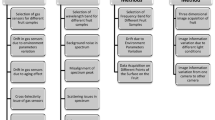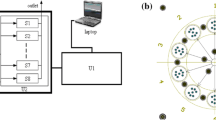Abstract
In this study, we have developed a conveyor e-Nose system for the non-destructive quality evaluation of litchi fruit. A pair of electronic noses with an optimized sensor array of six sensors was adopted to test two litchi fruits at a time when passing through two channels of the running conveyor belt and halt below the e-Nose for a few seconds. The study started with sensor array optimization using a sensitivity test. Three methods were employed for sensor optimization. And the results of all the three methods are quite similar to each other. After acquiring data about the aroma volatiles of the sample and from the electronic nose, Principal Component Analysis (PCA) was employed to see the pattern differences between good litchi and rejected litchi. The experimental results showed that the patterns of the two categories are different from each other. As the clustering of two patterns is prominent, data analysis for classification is employed. 123 data were taken for two categories of litchi. After acquiring aroma volatiles from a sensory array of good and rotten litchi, the data was analyzed and compared using SVM, Logistic Regression, KNN, decision tree and random forest classifier models. SVM and Logistic Regression showed the lowest accuracy rate. As the decision tree model shows the lowest error rate, it is applied and integrated into the system to allow the classification of good and rejected litchi.
Access this chapter
Tax calculation will be finalised at checkout
Purchases are for personal use only
Similar content being viewed by others
References
Choudhary, J. S., Prabhakar, C. S., Das, B., & Kumar, S. (2013). Litchi stink bug (Tessaratoma javanica) outbreak in Jharkhand, India, on litchi. Phytoparasitica, 41(1), 73–77.
Wang, Y., Wang, H. C., Hu, Z. Q., & Chen, H. B. (2010). Litchi good for heath from skin to heart: An overview of litchi functional activities and compounds. In Proceedings of 3rd IS on Longan, Lychee & Other Fruit, Acta Hort. 863, ISHS 2010
Xu, S., Lü, E., Lu, H., Zhou, Z., Wang, Y., Yang, J., & Wang, Y. (2016). Quality detection of litchi stored in different environments using an electronic nose. Sensors, 16(6), 852.
El-Mesery, H. S., Mao, H. & El-Fatah Abomohra, A. (2019). Applications of non-destructive technologies for agricultural and food products quality inspection. Sensors, 19, 846. https://doi.org/10.3390/s19040846.
Loutfi, A., Coradeschi, S., Mani, G. K., Shankar, P., & Balaguru Rayappan, J. B. (2015). Electronic noses for food quality: A review. Journal of Food Engineering, 144, 103–111.
Keller,P. E., Kangas, L. J., Liden, L. H., Hashem, S., & Kouzes, R. T. (1992). Electronic noses and their applications. In IEEE Northcon/Technical Applications Conference (TAC’95) in Portland.
Wu, Y., Zhu, B., Tu, C., Duan, C., & Pan, Q. (2011). Generation of volatile compounds in litchi wine during winemaking and short-term bottle storage. Journal of Agriculture and Food Chemistry, 59, 4923–4931.
Wilson, A. D., & Baietto, M. (2009). Applications and advances in electronic-nose technologies. Sensors (Basel), 9(7), 5099–5148.
Sharma, M., Ghosh, D., & Bhattacharya, N (March, 2013). Electronic nose—A new way for predicting the optimum point of fermentation of Black Tea. International Journal of Engineering Science Invention. ISSN (Online): 2319 – 6734, ISSN (Print): 2319 – 6726.
Tang, K.-T., Chiu, S.-W., Pan, C.-H., Hsieh, H.-Y., Liang, Y.-S., & Liu, S.-C. (2010). Development of a portable electronic nose system for the detection and classification of fruity odors. Sensors, 10, 9179–9193.
Karakaya, D., Ulucan, O., & Turkan, M. (2020). Electronic nose and its applications: A survey. International Journal of Automation and Computing. 17(2), April 2020.
Kusumiyati, Hadiwijaya, Y., Putri, I. E. (2019). Non-destructive classification of fruits based on Uv-Vis-Nir spectroscopy and principal component analysis. Jurnal Biodjati, 4(1):89–95, May 2019.
Acknowledgements
The financial support provided by the Department of Science & Technology, New Delhi, India, is duly gratefully acknowledged.
Author information
Authors and Affiliations
Corresponding author
Editor information
Editors and Affiliations
Rights and permissions
Copyright information
© 2023 The Author(s), under exclusive license to Springer Nature Singapore Pte Ltd.
About this paper
Cite this paper
Biswas, S.P., Roy, S., Bhattacharyya, N. (2023). Non-destructive Quality Evaluation of Litchi Fruit Using e-Nose System. In: Noor, A., Saroha, K., Pricop, E., Sen, A., Trivedi, G. (eds) Proceedings of Emerging Trends and Technologies on Intelligent Systems. Advances in Intelligent Systems and Computing, vol 1414. Springer, Singapore. https://doi.org/10.1007/978-981-19-4182-5_15
Download citation
DOI: https://doi.org/10.1007/978-981-19-4182-5_15
Published:
Publisher Name: Springer, Singapore
Print ISBN: 978-981-19-4181-8
Online ISBN: 978-981-19-4182-5
eBook Packages: Intelligent Technologies and RoboticsIntelligent Technologies and Robotics (R0)




